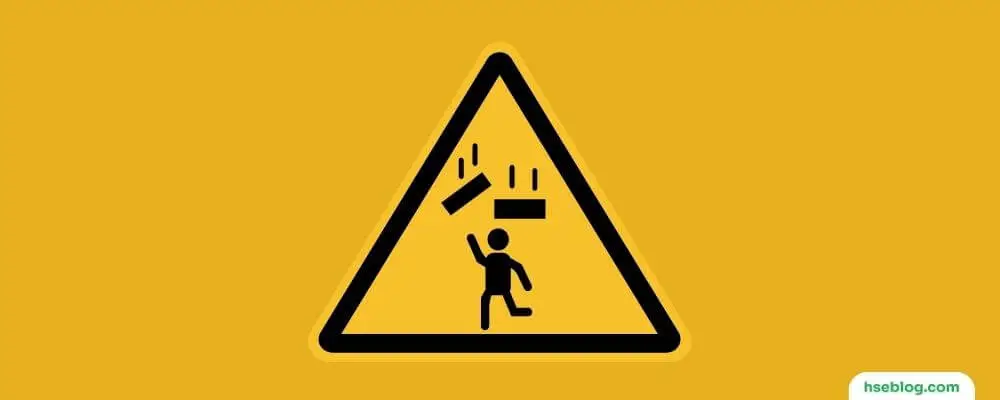Every day, countless workplaces are subjected to the risk of falling objects. From construction sites and warehouses to retail environments, the hazards posed by unsecured materials or equipment can be significant and, at times, fatal. When these objects fall from height, the potential for injury, or even worse, death, is substantial. Understanding these hazards and implementing effective control measures is crucial in maintaining the safety of workers and bystanders alike.
In this article, we’ll explore the common scenarios that lead to such accidents, uncover the typical falling object hazards across different industries, and, importantly, outline the preventative measures that can be taken to minimize these risks.
Whether you’re an employer looking to enhance your workplace safety protocols, a safety officer assigned to oversee these precautions, or a worker interested in understanding the risks associated with your profession, this blog post will provide you with valuable insights and practical solutions to help safeguard everyone involved. Read on to equip yourself with the knowledge to create a safer and healthier work environment.
What are Falling Objects?
Falling objects refer to any items or materials that fall from a height or elevated position, posing a risk of injury or damage to people or property below. These objects can include tools, equipment, materials, debris, or structural components that become loose or unstable due to improper securing, environmental conditions, human error, or equipment failure.
Types of Falling Objects:
- Unsecured tools or materials – Items that are not properly secured during work at height.
- Environmental factors – High winds or vibrations causing objects to dislodge.
- Structural failure – Weak or deteriorated fixtures giving way.
- Dropped loads – Items falling from cranes, forklifts, or other lifting equipment.
- Human error – Improper handling or stacking of materials.
Risks and Consequences:
- Injuries – Head trauma, fractures, cuts, or even fatalities.
- Property damage – Equipment or structures can be damaged by heavy or sharp falling objects.
- Operational disruption – Worksite shutdowns or delays due to accidents.
Falling Objects Hazards
Falling objects can pose significant hazards in various environments, including construction sites, warehouses, retail stores, and everyday life. Here are some typical falling object hazards:
- Unsecured Objects during Lifting Operations: This can involve items, such as boxes, dropping from a pallet as it is being hoisted by machinery like a forklift. These falling objects can pose a significant risk to workers below or nearby.
- Dislodgement of Objects during Work at Height: As workers perform tasks at elevated positions, items such as tiles can be dislodged from a rooftop, causing hazards to those beneath.
- Falling Objects due to Environmental Factors or Deterioration: Harsh weather conditions can lead to objects like scaffold planks cast off scaffolds in robust winds. Similarly, fixtures like ductwork might fall from a ceiling due to wearing out of their attachments.
- Toppling of Precariously Positioned Objects: This involves instability of objects that could easily fall over, such as a ladder that isn’t properly secured or a haphazardly stacked pile of items on shelves.
- Loose Materials on Elevated Surfaces: Construction or renovation sites often have loose materials or tools on elevated platforms or scaffolds. If these items aren’t secured, they may fall and injure workers below.
- Falling Trees or Branches: In outdoor work environments like forestry, landscaping, or general construction, workers may be at risk from falling trees or branches, especially during tree-cutting operations or in severe weather conditions.
- Collapse of Structures or Excavations: In certain industries, workers may be exposed to hazards from falling objects due to the collapse of structures (like buildings, bridges, etc.) or excavations.
- Failures of Lifting Equipment: The malfunction of cranes, hoists, or other lifting equipment can lead to loads being dropped, creating a falling object hazard.
- Objects Falling from Vehicles: During loading and unloading operations, objects may fall from vehicles if they’re not properly secured.
By understanding and recognizing these potential hazards, workers and employers can take proactive steps to minimize the risk of injury from falling objects. This can include measures like using proper safety gear, ensuring secure storage of tools and materials, and conducting regular equipment inspections and maintenance.

Preventing Falls and Falling Materials: Falling Object Hazards Controls
Proper planning and supervision of work are important to prevent falls from heights and falling materials. Those responsible for such work should be experienced and should use their knowledge to ensure:
- The selection and use of correct access equipment.
- Correct provision and handling of tools and materials (especially getting them up and down from work locations).
- Adequate information, instruction, and training for all persons who will be involved.
Regular inspections of the workplace, work equipment, and work methods are essential to reduce the risks. Unsafe acts should not be tolerated and should be stopped immediately, ensuring all employees know why the work is being stopped and the consequences if further unsafe work is carried out. Unsafe conditions should be corrected on the spot.
A simple hierarchy can be adopted to prevent falls:
- Provide a safe working platform with guardrails, fences, toe-boards, etc., that are strong enough to prevent falls.
- Where this is not possible or reasonable, provide properly installed personal equipment, such as rope access or boatswain’s chairs.
- If this is impossible and a worker can approach an unprotected edge, provide equipment that will arrest falls, such as a safety harness or safety net.
This last option does not prevent falls but minimizes the fall’s distance and the consequences (i.e., injury).
Prevention of injury caused by falling materials should be controlled using a similar approach:
- Prevent materials from falling using physical safeguards such as toeboards and brick guards (see later).
- If risk remains, use physical safeguards to prevent falling objects from hitting people below, such as debris netting, fans (wooden shielding angled to catch debris), and covered walkways.
1. Guardrails and Toeboards
Wherever possible, protection should be provided at all unprotected edges to prevent people and materials from falling. This can be achieved by means of guardrails, toeboards, and brick guards on scaffolding and other platforms. Guardrails are designed to prevent people from falling, whereas toeboards and brick guards are principally designed to stop materials from falling.
The key characteristics of any guardrail are that it should:
- Fully enclose all of the exposed unprotected edges.
- Be robust enough to not bend or distort when fallen against (e.g., it should not be a chain or rope).
- Be securely fixed in position so it will withstand any foreseeable impact.
- Be high enough to prevent a person from toppling over the top.
- It has no excessively large gaps through which a person could fall.
Toeboards are usually scaffolded planks on their edge at right angles (90°) to the working platform. They are laid at the outer edges and ends of the working platform, although sometimes, the inner edge (nearest the building) also requires edge protection. Toeboards prevent small objects like rubble and tools from being casually kicked off the platform.
Brick guards prevent a more substantial amount of material from falling and have a secondary function of helping prevent people from falling as well.
The principle of using guardrails, toeboards, and brick guards can be applied to the edges of flat roofs, scaffolds, mobile tower scaffolds and Mobile Elevating Work Platforms (MEWPs, such as cherry-pickers), and access cradles (as used for window cleaning). Any gaps in edge protection (e.g., allowing access by ladder) should be the minimum required for reasonable access.

2. Work Platforms
Work platforms (e.g., on a scaffold tower) should be:
- Sufficiently large to allow safe use.
- Capable of bearing the loads imposed upon them.
- Fully boarded to prevent gaps that could present tripping hazards or allow materials or people to fall through.
Usually, the platform comprises scaffold boards resting on the scaffold framework. The boards should be free from significant defects, such as rotted timber, large cracks, split ends, or large/numerous notches cut into the wood. Usually, boards should be supported by three support members. Boards should not have long overlaps beyond their supports (because of the possible see-saw effect).
3. Suspended Access Equipment
Suspended access equipment usually consists of a suspended cradle lowered into position from above. The cradle can be fully guarded with guardrails and toe-boards to provide a safe work platform. In some instances, using this equipment is not practicable, so it may be necessary to use personal suspended-access equipment, such as a boatswain’s chair.
A boatswain’s chair can be used for light, short-term work. The chair usually consists of a seat with a back, a suspension point, and a means for carrying tools. The user should be attached to the chair by a harness to prevent falls. The user controls descent based on the same techniques as abseiling, although there should not be a single suspension point.
4. Head Protection
Construction and industrial sites always risk falling or moving objects, so they should be mandatory for hard-hat areas. A hard hat protects the wearer from a severe head injury as a result of the following:
- The impact from small objects that fall.
- Being struck by moving objects.
It will not protect the wearer from heavy impacts, such as might occur if the object is very large and heavy (e.g., a scaffold tube) or is dropped from a great height (e.g., a hammer from 10 stories up). Therefore, alternative methods should be used to prevent falling objects and control moving objects.
In certain situations where a worker is at risk of striking their head in the event of a fall, it is more appropriate to wear a climbing helmet rather than a hard hat. A climbing helmet is designed to give protection against falling objects and impact to the head in the event of a fall and will have a chin strap with four points of attachment.
5. Emergency Rescue
Emergency procedures must be developed for reasonably foreseeable events where workers might become trapped while working at height (e.g., unable to climb back after falling in a safety harness).
The method of rescue may well be simple, such as putting a ladder up to a net and allowing the fallen person to descend. In other circumstances, the use of other work equipment may need to be considered, such as MEWPs or proprietary rescue systems. Whatever method is selected, arrangements should be available to rescue a person, and employers must ensure that those involved are trained in the procedures and that the equipment required is available.

Prevention Of Falling Objects/Materials Through Safe Stacking And Storage
It is estimated that two million working days are lost each year regarding handling injuries and slip and trip incidents. Such incidents can occur in warehouses and storage facilities when palletized goods are stacked higher than two stories and often weigh several tonnes. Implementing tried and tested methods for safe racking and storage is essential to mitigate the risks of an incident.
It is often possible to remove high-level storage from offices and other general workplaces, such as construction sites, and provide storage in warehouses or similar storage facilities. If a storage facility is to be installed for the first time, then the following points should be considered:
- The racking must be erected on and fixed securely to a sound, level floor.
- The storage system must be installed in accordance with the manufacturers’ instructions.
- If the racking is to be secured to the wall of a building, has this been proved by structural calculations that should be made to ensure that the walls can support the racking and its contents securely?
- Beam-connector locks must be fixed at both ends of the beam.
- Maximum-load notices must be displayed.
- Correct pallets must be used.
- Sufficient protective equipment, such as column guards and rack-end protectors, must be used.
Management and employees should familiarise themselves with the racking systems used and ensure they understand the difference between general wear and tear and real damage to help them identify potentially dangerous situations as early as possible. Storage racking is particularly vulnerable and should be strong and stable enough for the loads it has to carry. Damage from vehicles in a warehouse can easily weaken the structure and cause collapse. Uprights need protection, particularly at corners.
The following action can be taken to keep racking serviceable:
- Inspect them regularly and encourage workers to report any problems/defects.
- Post notices with maximum permissible loads and never exceed the loading.
- Use good pallets and safe stacking methods.
- Band, box, or wrap articles to prevent items from falling.
- Set limits on the height of stacks and regularly inspect to ensure that limits are being followed.
- Provide instruction and training for staff and special procedures for difficult objects.
Regular visual inspections should be carried out and documented to resolve any damage quickly. In particular, staff should be trained to act if damage occurs to and affects:
- the cross-sectional profile of the main load beam;
- the straightness of beams, bracing, or uprights; and
- the welds and joints, or bolts and clips.
Shelving and storage solutions can be installed to guard against back strains and other injuries, allowing access and retrieval of stock at a comfortable, ergonomic height. Products such as vertical storage machines or pallet pull-out units are possible solutions, as they are designed to reach stock without unnecessary straining.
Generally, storage racks should be examined by a qualified inspector approved by the Storage Equipment Manufacturers’ Association (SEMA) at least once or twice a year.

During an inspection, particular attention will be paid to beams, uprights, frame bracing, floor fixings, and lock-in clips, as indicated in the SEMA Code of Practice, guideline no. 6. The following will also be subject to general observations:
- Pallet locations on beams;
- Conditions and types of pallets;
- Positioning of loads and types of loads stored on pallets;
- General fork-lift operatives’ use of the racking;
- The condition and type of floor on which the racking is fixed;
- General housekeeping of the installation and
- Possible changes from the original design requirements.
With warehouse managers relying increasingly on temporary and agency workers, who sometimes have little or no prior experience working in warehouse or storage environments, it is vital that safety training becomes part of the induction process.
All materials used in the construction process on-site must be stacked or stored safely. This will keep the site tidy and reduce slip and trip hazards. It will also help to reduce the risk of fire. Dangerous substances should be kept in a safe place in a separate building or open air. Only small quantities of hazardous and/or flammable substances should be kept on the site. Any more significant amounts that cannot be kept outside in a safe area should be kept in a special fire-resisting store that is well-ventilated and free of ignition sources. Flammable gas cylinders also need to be stored and used safely.
Conclusion
As we conclude this comprehensive discussion on falling objects hazards and their control measures, it’s crucial to emphasize that safety must be a top priority in any workplace. Proactive measures like using proper safety gear, ensuring secure storage, regular equipment inspections, and training can significantly reduce falling object accidents.
By creating a culture of safety, we can mitigate risks, boost productivity, lower insurance costs, and improve worker morale. Employers, employees, safety equipment vendors, and regulators are responsible for making the workplace as safe as possible. Ultimately, awareness and action are essential for preventing injuries and creating a safer, healthier, and more productive work environment.

